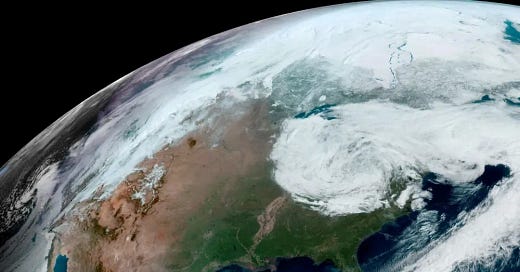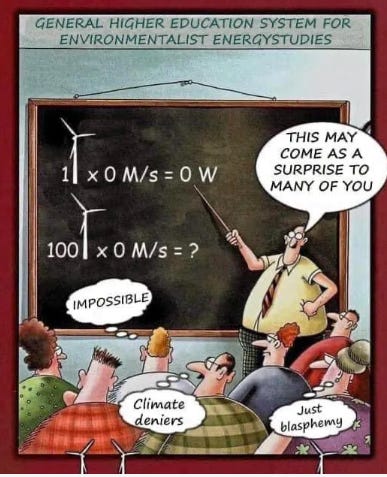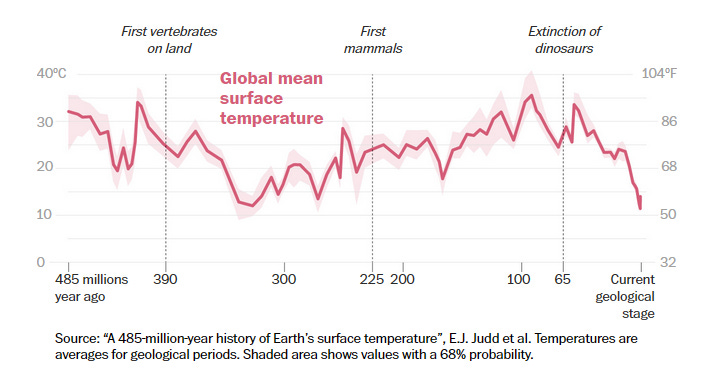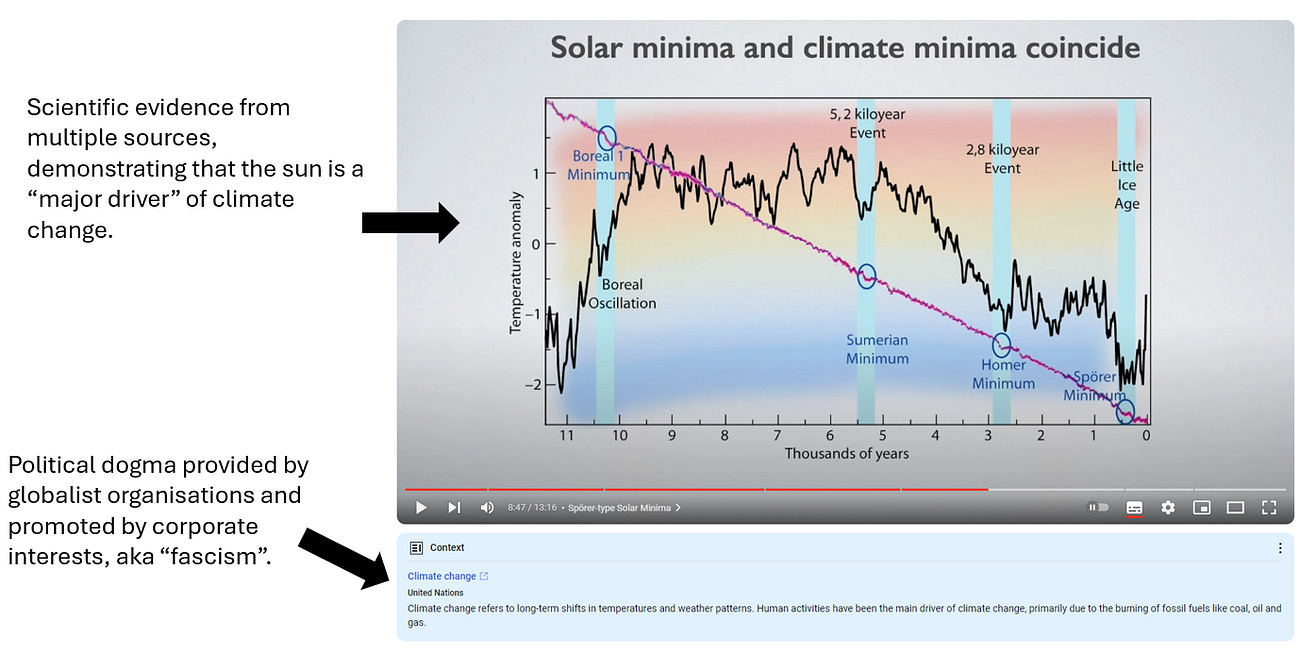I asked Google NotebookLM to debate potential anthropogenic, CO2 driven, climate change versus the opposing view.
I gave it the official IPCC report in favour of the hypothesis and a number of articles I have written or shared in this Substack.
I continue to be impressed by its balanced and nuanced interpretation.
Summary
This briefing document explores divergent perspectives on climate change and Net Zero policies. It compiles views ranging from the IPCC's scientific consensus, which attributes recent warming primarily to human-caused greenhouse gas emissions and highlights observed impacts and future risks, to skeptical viewpoints that emphasize natural climate variability, critique the Net Zero agenda as economically detrimental, and question the scientific evidence linking warming to human activity, with one source describing "global boiling" as "clearly absolute nonsense." The document also touches on the reliability and environmental concerns associated with renewable energy and different interpretations of historical climate data.
Discussion
This briefing document synthesizes the main themes and important ideas presented in the provided sources regarding climate change. The sources present a range of perspectives, from a strong critique of mainstream climate science and policy to a comprehensive assessment of observed warming, its causes, projected impacts, and mitigation/adaptation efforts.
Summary of Contrasting Perspectives
The provided sources offer a stark contrast in perspectives on climate change.
The IPCC report presents a scientific consensus view, asserting that global warming is unequivocal, primarily human-caused due to greenhouse gas emissions, and is already resulting in significant negative impacts and risks. It outlines the need for urgent and widespread mitigation and adaptation efforts, emphasizing international cooperation and financial support. The report provides detailed data on observed warming, emission trends, and projected future changes and risks under different warming scenarios.
In contrast, the excerpts from "Climate Change and The Corruption of Science" and the interview with Professor Ian Plimer strongly challenge the mainstream narrative. They argue that current warming is likely driven by natural cycles, dismiss the Net Zero agenda as economically and environmentally damaging, and question the scientific basis for attributing warming to human CO2 emissions. They portray the climate movement as politically motivated and relying on fear-mongering rather than evidence. Professor Plimer specifically highlights the historical precedence of climate change driven by natural factors and downplays the role of CO2, while also pointing to environmental concerns associated with renewable energy technologies. The excerpt regarding Professor Valentina Zharkova further supports the idea of solar influence on climate variability. The excerpt regarding Bolivia's temperature data raises questions about data accuracy or interpretation in assessing warming trends.
These sources highlight a significant divide in the understanding and interpretation of climate science, the perceived causes of climate change, the effectiveness and desirability of proposed solutions, and the underlying motivations behind climate policies.
Source 1: Excerpts from "Climate Change and The Corruption of Science"1
Main Themes:
Skepticism regarding man-made global warming: The author fundamentally rejects the premise that current global warming is primarily driven by human activity.
Critique of the Net Zero agenda: The Net Zero target is presented as a destructive, economically damaging, and pointless policy driven by malicious intent.
Emphasis on natural climate variability: Historical climate changes are attributed primarily to natural factors, particularly the sun.
Ineffectiveness and environmental damage of renewable energy: Wind and solar power are portrayed as unreliable and environmentally harmful, relying heavily on subsidies.
Political and societal manipulation: The author suggests that "climate change" is a tool for control by a "Uniparty" and "globalist paymasters," with the public and some politicians being "useful idiots" suffering from "tribal derangement syndrome."
Most Important Ideas/Facts:
The assertion that historical climate changes (Roman Warm Period, Little Ice Age, etc.) were primarily driven by the sun.
The claim that minimum wind electricity generation in the UK has barely changed despite capacity doubling, illustrating the intermittency issue.
The argument that solar power is even more intermittent and problematic.
The belief that the Net Zero agenda is an attempt to "cripple the UK economy and impoverish the nation and its people."
The characterization of mainstream climate concern as "30 years of brainwashing" and "tribal derangement syndrome."
The claim that "Vote Uniparty (Labour, or the Conservatives, or the Lib Dems, or the SNP) to send your children and grandchildren back to living in the middle ages! The Reform UK Party is the only Westminster party committed to scrapping Net Zero."
The accusation that proponents of Net Zero are "unknowing 'useful idiots'" or "fully aware of the critical damage they are wilfully inflicting on the country at the behest of their Malthusian globalist overlords."
Source 2: Excerpts from "Professor Valentina Zharkova and the Little Ice Age Which Has Already Started"2
Main Themes:
Emphasis on solar activity's influence on climate: This source highlights historical periods like the Maunder Minimum as evidence of the sun's significant impact on Earth's temperature.
Discussion of the "Little Ice Age": It describes the historical conditions during this cold period.
Suggestion that a new cold period may be starting: The title implies a belief in a pending cooling trend influenced by solar cycles.
Most Important Ideas/Facts:
The Maunder Minimum (1645-1715) saw weakened solar activity and significantly colder weather in Europe, with major rivers freezing and temperatures 5 to 7°C colder in some places.
This historical period serves as an example of dramatic climate change linked to solar activity.
Source 3: Excerpts from "Scientists have captured Earth’s climate over the last 485 million years. Here’s the surprising place we stand now."3
Main Themes:
Historical temperature data and current anomalies: This source touches on the existence of historical climate data and questions the current interpretation or collection of temperature data in certain regions.
Most Important Ideas/Facts:
Reference to a "wonderful baseline for Bolivia - a very high mountainous country - right up until 1990, when the data ends."
Questioning how a "very red rosy hot Bolivia" can be depicted on an anomaly map without recent temperature measurements. This suggests a potential concern about data collection or interpretation influencing reported warming.
Source 4: Excerpts from "https://www.ipcc.ch/report/ar6/syr/downloads/report/IPCC_AR6_SYR_LongerReport.pdf" (IPCC AR6 Synthesis Report)4
Main Themes:
Unequivocal warming and human causality: This is a central and highly confident finding.
Observed impacts and projected risks: The report details current and future adverse effects of climate change on natural and human systems.
Mitigation and adaptation efforts and their effectiveness: The document assesses existing and potential actions to reduce emissions and adapt to climate change.
The importance of international cooperation and finance: These are highlighted as critical enablers for climate action, particularly in developing countries.
The concept of climate resilient development: This framework integrates mitigation, adaptation, and sustainable development.
Remaining carbon budgets and pathways to limit warming: The report quantifies the amount of CO2 that can still be emitted to stay within specific warming limits.
Most Important Ideas/Facts:
Global surface temperature was around 1.1°C above 1850–1900 in 2011–2020 (high confidence).
Observed warming is "human-caused," with greenhouse gases (GHG), dominated by CO2 and methane, being the primary drivers (high confidence).
Global surface temperature has increased faster since 1970 than in any other 50-year period over at least the last 2000 years (high confidence).
The likely range of total human-caused global surface temperature increase from 1850–1900 to 2010–2019 is 0.8°C to 1.3°C, with a best estimate of 1.07°C.
Net GHG emissions have increased since 2010 across all major sectors, with energy, industry, AFOLU, transport, and buildings being the largest contributors (high confidence).
Regional contributions to global human-caused GHG emissions differ widely, with disparities based on development stages and income levels.
Climate change has already reduced food security and affected water security globally (high confidence).
Around half of the world's population currently experiences severe water scarcity for at least some part of the year (medium confidence).
The UNFCCC, Kyoto Protocol, and Paris Agreement are supporting increasing levels of national ambition and climate policies (high confidence).
Many regulatory and economic instruments have been deployed successfully for mitigation (high confidence).
Limiting warming to 1.5°C (>50%) with no or limited overshoot requires immediate and deep GHG emission reductions, necessitating emissions to be nearly halved by 2030 compared to 2019 levels (high confidence).
The remaining carbon budget for limiting warming to 1.5°C with a 50% likelihood from the beginning of 2020 is estimated to be 500 GtCO2.
Future warming will be driven by future emissions and will affect all major climate system components, with many changes being irreversible on centennial to millennial timescales (high confidence).
With every additional increment of global warming, changes in extremes continue to become larger (high confidence).
Sea level rise and other irreversible changes will continue for thousands of years (high confidence).
There are adaptation options effective in reducing climate risks, particularly in sectors like agriculture, water management, and disaster risk management (high confidence).
Increased financial flows and international cooperation are critical for accelerating climate action, especially in developing countries (very high confidence and high confidence).
A rapidly narrowing window of opportunity exists to enable climate resilient development, which integrates emissions reductions, adaptation, and sustainable development goal achievement (high confidence).
Source 5: Excerpts from "“To Use Terms Like 'Global Boiling' Is Clearly Absolute Nonsense”" (Interview with Ian Plimer)5
Main Themes:
Rejection of "global boiling" and catastrophic climate predictions: Plimer dismisses strong climate rhetoric as hyperbole intended to instil fear.
Skepticism of the scientific consensus on anthropogenic global warming: He questions the mainstream view that human CO2 emissions are the primary driver of warming.
Emphasis on natural climate cycles and drivers: Plimer highlights the role of tectonic changes, astronomical changes, cosmic radiation, orbital cycles, solar activity, ocean currents, and volcanic activity in climate change.
The limited role of CO2 in climate change: He argues that CO2's warming effect is limited due to atmospheric saturation and that temperature rise precedes CO2 increase in historical data.
Critique of the environmental impact of "green technologies": Plimer points to the use of toxic materials and disposal issues associated with wind turbines and solar panels.
Defence of geology and mining: He refutes the idea that his association with mining companies compromises his scientific views, arguing that modern life relies on geology and mining.
Most Important Ideas/Facts:
Plimer's assertion that "global boiling" is "absolute nonsense" and a tactic to frighten people.
His argument that "belief is used in politics, it's used in religion," not in science, which requires evidence.
His claim that historical climate changes are cyclical and influenced by various natural factors, with the sun being a key driver.
His statement that "climate is very complicated. It's not based on a simple gas, carbon dioxide."
His argument that increasing CO2 has a diminishing warming effect due to atmospheric saturation.
His claim, based on ice core studies, that temperature rises before CO2 levels increase, suggesting warming causes CO2 release from oceans, not the other way around.
His observation that past ice ages started when CO2 levels were higher than today.
His assertion that anthropogenic CO2 emissions account for only 3% of the total CO2 cycle.
His claim that it has "never been shown that human emissions of carbon dioxide drive global warming."
His argument that CO2 is "plant food" and shouldn't be reduced.
His examples of environmental damage from solar panels (lead, cadmium) and wind turbines (bisphenol), highlighting their relatively short lifespan and disposal challenges.
His defence of his work in geology and mining as essential for modern society.
Source 6 - Anthropogenic Global Warming IV
Randomness ... Uncertainty ... Tim Ellison6
This source, "Anthropogenic Global Warming IV" by Tim Ellison, argues that recent changes in Earth's temperature are not unprecedented or necessarily caused by human activity. The author highlights Milankovitch Cycles as a primary driver of long-term climate shifts, but points to short-term, apparently-random changes that he believes are likely caused by factors like the sun or space weather. He analyzes data to suggest that recent temperature changes fall within the range of historical random fluctuations, deeming claims of unprecedented warming unfounded based on the data presented.
Source 7 - CO2 Does Not Cause Global Warming - by Joel Smalley7
This piece summarizes recent work by three physicists suggesting that the effect of increased atmospheric CO2 on temperature might be limited. They propose that CO2's capacity to absorb radiation reaches a point of saturation, meaning that after a certain concentration, adding more CO2 doesn't significantly increase heat absorption. This concept is likened to painting a white surface black, where subsequent coats after the first or second have diminishing returns on heat absorption. The authors of the source material highlight these findings from peer-reviewed papers, presenting them as evidence that emitted CO2 does not directly cause an increase in global temperature due to these saturation processes.
Source 8 - Climate Change, the Sun and Human Development - Javier Vinós, Climate Researcher8
This piece argues that while science suggests a strong association between solar activity and global temperature changes over thousands of years, the dominant narrative attributing climate change solely to human burning of fossil fuels is dogmatic fiction. It proposes a method using climate proxies and radiocarbon dating to compare ancient temperatures with solar activity and human development, concluding that periods of low solar activity and resulting cooler temperatures have historically hindered human flourishing, suggesting higher temperatures are not inherently dangerous. Ultimately, the author asserts that natural factors affecting climate are significantly larger than human impact, rendering current policy reactions based on anthropogenic warming largely unfounded and potentially detrimental to human progress.
Source 9 - Climate Change: A Tale of Two Theories - by Stephen Andrews9
This newsletter article presents a challenge to the commonly accepted idea that human-caused carbon emissions are the primary driver of current climate change. Instead, the author proposes that two alternative theories, the Cosmic Ray Hypothesis and the Winter Gatekeeper Hypothesis, offer more plausible explanations for the observed rise in global temperatures since 1850, citing several graphs from independent data sources that demonstrate a strong correlation between solar cycles, cosmic rays, ocean and atmospheric heat transport, and temperature changes. The author suggests that these natural factors, not CO2, are the root cause of recent warming trends and that efforts to reduce carbon emissions would consequently be ineffective.
Source 10 - Debunking the climate change hoax - by Joel Smalley10
This piece, presented as a foreword by Joel Smalley to an essay by Douglas Brodie titled "Dead Man Talking," argues that climate change is a politically motivated deception designed to impose totalitarian control and redistribute wealth. Brodie asserts that this "hoax" originated from anti-capitalist ideologies and influential figures, criticizing the scientific basis for man-made CO2 warming and highlighting alleged data manipulation by institutions like the UN IPCC. He contends that "Net Zero" policies are economically harmful and ineffective, advocating for public skepticism towards the establishment narrative and urging people to vote against mainstream political parties supporting climate policies. The text aims to expose what the author sees as the "blatant falsehoods" of the establishment's climate change narrative, providing alternative explanations like solar activity for past warming periods and pointing to what he describes as evidence of manipulation in temperature records.
Source 11 - The Story Beneath the Climate Story - Julius Ruechel11
This source, titled "The Story Beneath the Climate Story" by Julius Ruechel, argues that the focus on carbon dioxide as the primary driver of climate change is a significant deception. Ruechel contends that climate is influenced by a complex interplay of natural forces, such as solar cycles, ocean currents, and planetary wobbles, making the emphasis on CO2 politically motivated rather than scientifically accurate. He posits that this narrow, oversimplified narrative, while containing a "kernel of truth," is ultimately misleading and prevents us from understanding the more profound factors at play, promising to elaborate on this with examples from his book, Plunderers of the Earth.
Source 12 - Unveiling Climate Mysteries: Debunking CO2's Role in Global Warming by Joel Smalley12
This text, an excerpt from "Unveiling Climate Mysteries," presents arguments challenging the widely accepted view that CO2 is the primary driver of global warming, drawing on insights from Howard ‘Cork’ Hayden, a professor emeritus of physics. The central idea is that Earth's energy imbalance, a key measure of climate change, is likely caused by a decrease in the Earth's albedo (reflectivity), leading to more absorbed solar radiation, rather than an increase in greenhouse gases like CO2. The author suggests that existing climate models are flawed because they don't adequately incorporate fundamental physical laws and that satellite data supports the significant role of albedo changes over CO2 in explaining recent warming trends.
Glossary of Key Terms
Net Zero: The state where anthropogenic greenhouse gas emissions are balanced by anthropogenic removals over a specified period.
Uniparty: A term used in one source to refer collectively to major UK political parties (Labour, Conservatives, Lib Dems, SNP), implying a shared agenda, specifically regarding Net Zero.
Roman Warm Period: A historical period of relatively warm climate roughly corresponding to the Roman Empire.
Dark Ages: A historical period following the Roman Warm Period, often associated with colder temperatures.
Medieval Warm Period: A historical period of relatively warm climate in the North Atlantic region, preceding the Little Ice Age.
Little Ice Age: A period of regional cooling, particularly in the North Atlantic, from roughly the 14th to the 19th centuries.
Maunder Minimum: A period from 1645 to 1715 when sunspots became extremely rare, associated with a cooling period in the Northern Hemisphere.
Wind Electricity Generation: Electricity produced from wind turbines.
Solar Panels: Devices that convert sunlight into electricity.
Intermittent: Referring to a power source that is not continuously available due to factors like weather conditions (wind, sunlight).
Anthropogenic Global Warming: Global warming attributed to human activity, primarily through the emission of greenhouse gases.
Tectonic Changes: Changes in the Earth's crust due to the movement of tectonic plates.
Astronomical Changes: Changes related to celestial bodies and their movements, potentially influencing Earth's climate.
Cosmic Radiation: High-energy particles from space, hypothesized by some to influence cloud formation and climate.
Orbital Cycles: Long-term cycles of changes in Earth's orbit and tilt, influencing the amount of solar radiation received.
Solar Activity: Variations in the Sun's energy output, such as sunspot cycles.
Ocean Currents: Large-scale movements of water in the oceans, which play a significant role in heat distribution.
Volcanic Activity: Eruptions and emissions from volcanoes, which can release gases and particles into the atmosphere, potentially affecting climate.
Greenhouse Gas (GHG): Gases in the atmosphere that absorb and emit radiant energy, causing the greenhouse effect. Examples include carbon dioxide (CO2), methane (CH4), and nitrous oxide (N2O).
Atmospheric Saturation (of CO2): The idea that adding more CO2 to the atmosphere has a diminishing warming effect as the absorption bands become saturated.
Ice Core Studies: The analysis of ice cores extracted from glaciers or ice sheets to reconstruct past climate conditions, including atmospheric composition and temperature.
Anthropogenic CO2 Emissions: Carbon dioxide emissions resulting from human activities, primarily the burning of fossil fuels and land-use change.
Green Technologies: Technologies considered environmentally friendly or designed to reduce human impact on the environment, such as wind turbines and solar panels.
Disposal Issues: Challenges related to the environmentally sound disposal of waste materials.
Bisphenol: A chemical compound used in the production of certain plastics and resins, with potential health concerns.
Geology: The scientific study of the Earth, including its rocks, minerals, landforms, and processes.
IPCC AR6 Synthesis Report: The Sixth Assessment Report Synthesis Report of the Intergovernmental Panel on Climate Change, summarizing the findings of the AR6 cycle.
Global Surface Temperature: The average temperature of the Earth's surface, including land and ocean.
Aerosol Cooling: The cooling effect on climate caused by aerosols (fine particles) in the atmosphere reflecting sunlight.
Food Security: The state of having reliable access to a sufficient quantity of affordable, nutritious food.
Water Security: The capacity of a population to safeguard sustainable access to adequate quantities of acceptable quality water for sustaining livelihoods, human well-being, and socio-economic development.
Cryospheric Elements: Parts of the Earth's surface where water is in solid form, including ice sheets, glaciers, snow cover, and permafrost.
Climatic Extremes: Extreme weather and climate events, such as heatwaves, heavy precipitation, and droughts.
Sustainable Development Goals (SDGs): A collection of 17 interlinked global goals designed to be a "blueprint to achieve a better and more sustainable future for all."
Remaining Carbon Budget (RCB): The maximum amount of net anthropogenic CO2 emissions from a given point in time that would result in limiting global warming to a given level with a given probability.
Climate Resilient Development: Development that anticipates, prepares for, and responds to climate change impacts.
UNFCCC (United Nations Framework Convention on Climate Change): An international environmental treaty on climate change.
Kyoto Protocol: An international treaty that committed state parties to reduce greenhouse gas emissions.
Paris Agreement: A legally binding international treaty on climate change.
Nationally Determined Contributions (NDCs): Climate action plans submitted by countries under the Paris Agreement.
Mitigation: Actions to reduce greenhouse gas emissions or enhance their removal from the atmosphere.
Adaptation: Actions to adjust to actual or expected future climate change and its effects.
Losses and Damages: Adverse observed impacts and/or projected risks from climate change, which can be economic and/or non-economic.
Confidence: A qualitative measure of the validity of a finding, based on the type, amount, quality, and consistency of the evidence and the degree of agreement among experts.
Likelihood: A quantitative measure of the probability of an outcome or result.
Global Warming Levels (GWLs): The amount of global surface temperature increase relative to a defined baseline period (e.g., 1850-1900).
Sea Level Rise: The increase in the average global sea level.
Ocean Acidification: The decrease in the pH of the ocean caused by the uptake of carbon dioxide from the atmosphere.
Ocean Deoxygenation: The loss of dissolved oxygen from the ocean.
Permafrost Thawing: The melting of permanently frozen ground.
Global Monsoon Precipitation: The seasonal rainfall associated with monsoon systems around the world.
Fire Weather: Weather conditions that are conducive to the ignition and spread of wildfires.
Compound Extreme Events: The occurrence of multiple extreme events simultaneously or in sequence, leading to compounding impacts.
Climate Finance: Local, national or transnational financing, drawn from public, private and alternative sources of financing, that seeks to support mitigation and adaptation actions to address climate change.
Sustainable Development: Development that meets the needs of the present without compromising the ability of future generations to meet their own needs.
Just Transitions: Processes and outcomes that seek to ensure that the benefits of transitioning to a low-carbon economy are widely shared, while mitigating the negative impacts on workers and communities.
Demand-Side Measures: Actions that influence the demand for goods and services, aiming to reduce associated greenhouse gas emissions.
Life Cycle Basis: An assessment that considers the environmental impacts of a product or activity throughout its entire life cycle, from raw material extraction to disposal.
Scientists have captured Earth’s climate over the last 485 million years. Here’s the surprising place we stand now.
Courtesy of The Washington Post.
Climate Change, the Sun and Human Development - Javier Vinós, Climate Researcher
Introduction - Evidence-based Reasoning vs Dogma in One Picture















Share this post